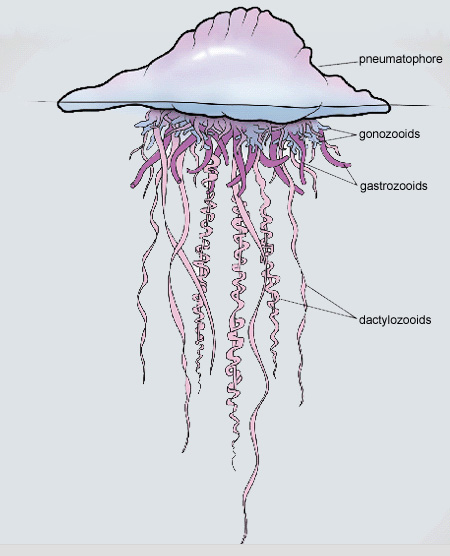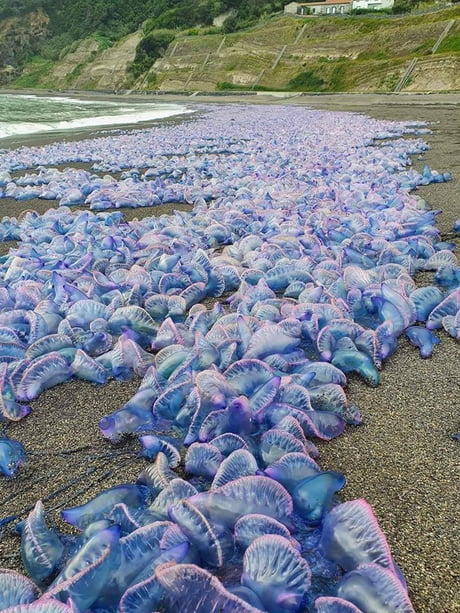Information borrowed from mentalfloss.com, oceana.org, floridamuseum.ufl.edu, ourbreathingplanet.com, and oceanconservancy.org

1. Portuguese Man O’Wars may resemble jellyfish because of their “bell” and tentacles, but they’re actually completely different. Man O’Wars are siphonophores, which are a type of hydrozoan comprised of a colony of specialized animals called zooids that work together as one. Although both jellyfish and the Man O’War are part of the phylum Cnidaria, true jellyfish are in the class Scyphozoa, while Man O’Wars are in class Hydrozoa. All that to say, they’re not jellyfish, but they can still sting.
2. Each Portuguese Man O’War is comprised of genetically-identical individuals called zooids. Just like a coral head looks like one animal but is made up of many polyps, a Portuguese Man O’War looks like one organism but is made of many zooids. Zooids can perform different tasks depending on the needs of the organism. Parts of the animals include the pneumatophore, which is filled with gas and floats on the ocean surface; the dactylozooids, which are used for hunting and capturing prey; and the gonozooids and gastrozooids, which are used for reproduction and digestion.

3. Every colony has a specific sex. The Man O’ War’s gonozooids have sacs that house ovaries or testes—so each colony can therefore be considered “male” or “female.” Though marine biologists aren’t completely sure how the Man O’ War procreates, one theory is that the gonozooids release eggs and sperm into the open ocean, which become fertilized when they cross paths with floating eggs or sperm from other Man O’ War colonies. This “broadcast spawning” method of reproduction is also used by many species of coral, fan worms, sea anemone, and jellyfish.
4. The Portuguese man o’ war doesn’t swim. Instead, it is propelled by the wind and ocean currents.
5. The float is filled with gasses of a similar concentration to that found in the air in our atmosphere. Man-of-war floats contain these same gasses in similar ratios, but with a large proportion of carbon monoxide. Scientists hypothesize the man-of-war fills its float with carbon monoxide, gradually replacing it with air.
6. It lives its life entirely on the surface of the ocean. The gas-filled bladder (pneumatophore) stays on the surface, keeping it afloat. The rest of its body remains submerged, with the numerous tentacles dragging along beneath and behind it.
7. Individuals vary quite significantly in terms of overall physical size. Nevertheless, certain physical dimensions remain reasonably consistent among most of the specimens observed. First of all, its inflatable sack typically measures about 12” in length and 5” wide and 6” tall.
8. The prominent sail on its upperside, can be up to 11.8” long and stand up to 6” tall. It also displays color patterns of purple, pink, blue, and mauve.
9. The astonishing tentacles contain the feature for which it remains best known – it’s powerful venom. That holds true mainly due to their sheer average length of 30’ but some can grow up to 165’! That’s almost as long as the Leaning Tower of Pisa is tall!
10. The nematocysts (stinging cells) in their tentacles serve as its means of acquiring food. The toxins these secrete paralyzes and often kills the numerous small fish that it preys upon. Although not typically fatal to humans directly, multiple stings can cause paralysis, and can prove fatal if the human victim is in deep water. These cells can sting even if it’s dead or the tentacles are severed.
11. Legions consisting of over 1000 colonies have been observed floating around together. Because they drift along on (somewhat) predictable winds and ocean currents, it’s possible to anticipate where and when a lot of the creatures will show up. For example, the Gulf Coast’s Man O’ War season arrives in the winter months.

12. It got its name because the inflated pneumatophore resembles the sail of a 18th-century Portuguese warship, (I looked up pictures of the war ships. Personally, I don’t see the resemblance.)

13. It is solely a carnivorous species. The dangerous tentacles it develops serve as its means of acquiring food. The toxins they secrete paralyzes and often kills the numerous small fish that it preys upon. Although not typically fatal to humans directly, multiple stings can cause paralysis, which can prove fatal if the human victim is in deep water.

14. Given that tiny fish make up about 70 to 90 percent of the Man O’ War’s diet (it also eats shrimp and other crustaceans), the Portuguese Man O’ War Fish, is playing a dangerous game: It lives among the tentacles even though it’s not immune to its stings, swimming nimbly between the stingers, sometimes stealing it’s food or nibbling on the tentacles.

15. The Man O’ War does have some enemies. Loggerhead sea turtles and the bizarre-looking ocean sunfish are thick-skinned enough to eat them. The violet sea snail, uses a bubble raft to float near the surface of the water in the hope of encountering a man-of-war meal. There are also blue dragon sea slugs, which not only devour the Man O’ War but actively harvest and appropriate its toxins. After storing Man O’ War stinging cells in their own skins, the blue dragons can use it as a predator deterrent.


These things are huge!!


Beautiful, but very strange!
Isn’t God’s creativity amazing?!?!
And our own personal observation – – they pop like bubble wrap if you accidentally step on one. Or most likely even if you intentionally step on one. 😊
I hope you enjoyed your science and biology lesson!
